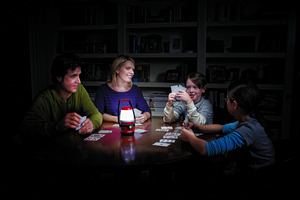MISSION, KS--(Marketwire - May 23, 2011) - (Family Features) Severe weather can strike in any state, at any time. According to the National Weather Service, there are an average of 10,000 thunderstorms, 5,000 floods, 1,000 tornadoes and two hurricanes that make landfall each year.
No matter where you live, you need to be prepared to deal with severe weather. If you have children, get them involved in planning and preparing -- it will help them learn what to do to stay safe. They can help pack emergency kits and make lists of other items such as books and games to keep them occupied, blankets and pillows, and pet care items.
These tips and checklists from Energizer will help you get ready before severe weather strikes.
Severe weather storm-ready checklist
- Know your community's warning systems for severe weather.
- Talk to someone at your local emergency management office to find out the types of severe weather or natural disasters most likely to happen in your area. Ask about animal care after a disaster as well.
- Pick a safe place in your home for family members to gather. For tornadoes, it should be a basement, storm cellar, or an interior room with no windows on the lowest floor. For severe thunderstorms, it should be away from windows and doors that could be broken by strong winds or hail.
- Have a hurricane evacuation plan in place which includes designated places to meet. When an evacuation is called, leave immediately.
- Practice severe weather drills so everyone knows where to go and what to do.
- If someone in your home is dependent on electricity powered medical equipment, make sure you have backup power available.
- Move or secure lawn furniture, trash cans or anything else that can be picked up by high winds.
- Make sure you know what plans your workplace and your child's school or day care center have for severe weather occurrences.
Emergency preparedness kit
The American Red Cross recommends that you have an easily accessible Emergency Kit ready for severe weather outbreaks and power outages. It should have supplies for at least three days.
- Water -- One gallon per person, per day, for drinking and for hygiene
- Food -- Nonperishable foods
- Flashlights or other battery-powered lighting devices
- Battery powered weather radio
- Extra batteries
- Cell phones and chargers
- First aid kit
- Medications
- Sanitation and personal hygiene items
- Copies of personal documents -- medical information, birth certificates, deed/lease to home, insurance policies, credit cards, etc. Keep them in a waterproof bag.
- Family and emergency contact information
- Extra cash
- Food, water and medication for pets
- Pack the items in easy-to-carry containers, such as duffle bags, backpacks or covered trash receptacles. Make sure the containers are clearly labeled.
What to do during a power outage
Power outages can range from a minor nuisance of an hour or two, to a prolonged outage of several days. Either way, keep these safety tips in mind:
- Turn off and unplug all unnecessary electronic equipment -- when the power comes back on, a power surge could damage it.
- Leave one light switched on so when the power does come on, you'll know right away.
- Do not use candles during a power outage -- the potential risk for fire is too great. Instead, use flashlights or lanterns, and make sure they are easily accessible to all family members. The line of Energizer Weather Ready lights feature long-lasting LED technology to provide extended run times.
- Keep refrigerator and freezer doors closed. An unopened refrigerator will keep foods safely cold for about 4 hours; a full, unopened freezer will keep its temperature for about 48 hours.
- If the power will be out for more than a day, use a cooler with ice for cold items.
For more information, visit www.energizer.com.
Let them know you're safe
If your community experiences a weather-related disaster, the American Red Cross can help you let friends and family know you are safe. Register on the Safe and Well website (safeandwell.communityos.org), or by calling 1-866-GET-INFO.
Know the difference between watch and warning
Severe Thunderstorm Watch: Severe thunderstorms are possible in and near the watch area.
Severe Thunderstorm Warning: Severe weather has been reported or indicated by radar. Warnings indicate impending danger to life and property.
Tornado Watch: Tornadoes are possible in and near the watch area.
Tornado Warning: A tornado has been sighted or is indicated by weather radar. Find shelter immediately.
Hurricane Watch: Hurricane conditions (sustained winds of 74 mph or higher) are possible within a specific coastal area. Generally issued 48 hours in advance of the anticipated onset of tropical storm force winds.
Hurricane Warning: Hurricane conditions (sustained winds of 74 mph or higher) are expected within a specific coastal area. Generally issued 36 hours in advance of the anticipated onset of tropical storm force winds.
Contact Information:
Wendy MacDonald
wmacdonald@familyfeatures.com
1-888-824-3337 ext. 235
http://editors.familyfeatures.com
